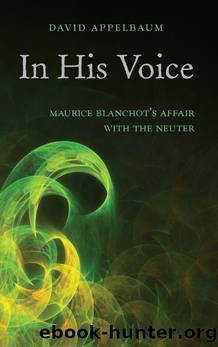In His Voice by David Appelbaum

Author:David Appelbaum
Language: eng
Format: epub
Publisher: State University of New York Press
Published: 2016-08-14T16:00:00+00:00
4
Echo
The receiver gave out a buzz of a kind that I had never before heard on a telephone. It was like the hum of countless children’s voices—but yet not a hum, the echo rather of voices singing at an infinite distance—blended by sheer impossibility into one high but resonant sound that vibrated on the ear as if it were trying to penetrate beyond mere hearing.
—Kafka, The Castle
The Auditory Image
The enigma of rhythm—dialectical-nondialectical, no more the one than the other is other—is the extreme danger.
—Maurice Blanchot, The Writing of the Disaster
Blanchot writes, “Speaking is not seeing” (IC, 25). Is speaking (writing, engagement with language) an act of renunciation, sacrifice, rational decision, whimsy? The statement has to do with the extent to which imagery is identified with vision and how image is shorthand for visual image. What is being given up? —Image as coextensive with vision, imago and eidos. At the margins, one begins to listen, to turn to the auditory on mute, as a genitive of image. With speaking or giving voice, images should be heard, not seen. This does not endorse, moreover, listening for descriptions of visual images, but for the image’s sonic appearance, or better, its vocality. Auditory imagery is generated outside the breathing of language, in hidden depths of the (breathless) imagination that brought Kant to awe. It is also sublime, in his sense of the word.
The turn toward the auditory (phonic, vocalic, vox and phone) goes hand in hand with Blanchot’s infrequent but highly charged mention of rhythm.1 His fondness for a Hölderlin citation: “Everything is rhythm; the entire destiny of man is a single, celestial rhythm, just as the work of art is a unique rhythm” (IC, 30).2 As if the image were sonically communicated through the materiality of words, phonemes and enunciations, their presence and absence, on mute. The senseless iteration and vibratory display of the outside—the vacuous power of the image—interrupts the dialectic of the symbolic order. The image, in particular, the acoustical image, exerts a force, an uncanny influence, on life in the world. Since that image “is not sensible” (and not supersensuous either), this is accomplished antinomously, by opening to what Blanchot calls “the mystery” (WD, 113). The acoustical image and the rhythm manifest in or by it operate in an ancient time capable of dephasing the temporal flow of everydayness. It is able to defeat the mastery of language wherever linguisticality is time-bound: always and everywhere. Rhythm and the acoustic image figure what is anterior to language—the arrhythmic rustling Levinas calls the il y a—that haunts it as an inefficacious double. Writing is the after-the-fact (nachträglich) account of the event of arche-language, a sensible record of the insensible, a likely abusive statement of the paradoxicality to which language bears witness. Writing then defines itself within the literary work.
The abandon of the visual image is not the abandon of the image tout court. Nor is it surrender of the gaze, that for which Merleau-Ponty constitutes the subject of visual perception, the given-to-be-seen.
Download
This site does not store any files on its server. We only index and link to content provided by other sites. Please contact the content providers to delete copyright contents if any and email us, we'll remove relevant links or contents immediately.
The Fine Print (Dreamland Billionaires Book 1) by Lauren Asher(2395)
Fury of Magnus by Graham McNeill(2362)
The Last House on Needless Street by Catriona Ward(2180)
The Rose Code by Kate Quinn(2073)
Malibu Rising by Taylor Jenkins Reid(1803)
Luster by Raven Leilani(1800)
Transcendent Kingdom by Yaa Gyasi(1770)
A Little Life: A Novel by Hanya Yanagihara(1742)
Moonflower Murders by Anthony Horowitz(1719)
The God of the Woods by Liz Moore(1562)
The Lost Book of the White (The Eldest Curses) by Cassandra Clare & Wesley Chu(1510)
This Changes Everything by Unknown(1421)
The Midwife Murders by James Patterson & Richard Dilallo(1376)
The Lying Life of Adults by Elena Ferrante(1348)
The New Wilderness by Diane Cook(1333)
Written in the Stars by Alexandria Bellefleur(1318)
Wandering in Strange Lands by Morgan Jerkins(1281)
Ambition and Desire: The Dangerous Life of Josephine Bonaparte by Kate Williams(1274)
The Lying Life of Adults by Elena Ferrante;(1231)
